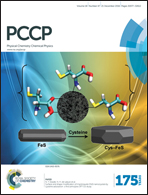Dirac fermions induced in strained zigzag phosphorus nanotubes and their applications in field effect transistors
Abstract
In this work, Dirac fermions have been obtained and engineered in one-dimensional (1D) zigzag phosphorus nanotubes (ZPNTs). We have performed a comprehensive first-principles computational study of the electronic properties of ZPNTs with various diameters. The results indicate that as the lattice parameter (Lc) along the axial direction increases, ZPNTs undergo transitions from metal to semimetal and semimetal to semiconductor, whereas Dirac fermions appear at Lc ranging from 3.90 Å to 4.10 Å. In particular, a field effect transistor (FET) based on 12-ZPNT (with 12 unit cells in the transverse direction) exhibits semiconductor behaviors with efficient gate-effect modulation at Lc = 4.60 Å. However, only weak gate modulation is demonstrated when the nanotube becomes a semimetal at Lc = 4.10 Å. This study indicates that ZPNTs are profoundly appealing for applications in strain sensors. Our findings pave the way for the development of high-performance strain-engineered electronics based on Dirac fermions in 1D materials.


 Please wait while we load your content...
Please wait while we load your content...